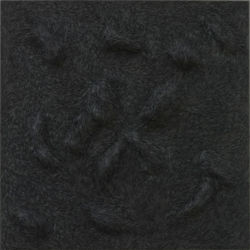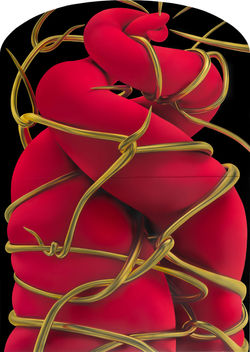Tang Contemporary Art is proud to announce the opening of “Variance,” an exhibition for artists Wu Wei and Li Erpeng, on March 28, 2020. Wu Wei’s installations and Li Erpeng’s paintings are characterized by highly saturated, intensely contrasting colors, clean lines, and complex forms suggestive of living organisms. At the same time, they respond through their work to alienated reality and the difficult circumstances we currently face; they transform and distort living power, and they resist industrialized structures.
Wu Wei’s works are made of paper, a choice of material that evolved from his early use of books. He adapted traditional paper cutting methods, transforming different colors of paper into fur. He then incorporated the layered embroidery techniques of thangka production into combinations of layered fur and forms that seem to undulate and grow. The texture of paper is emphasized in his long, complex process, done entirely by hand. This visual element easily triggers our psychological associations with animal fur, and the sense of touch is activated in the course of looking. The works are delicate yet warm, and they reflect Wu’s pursuit of primeval, hidden power.
Although his work is related to ancient mythical creatures, Wu Wei removes their narrative elements, shifting the focus to the forms of the animals and the grain of the fur. His color palette is as clean as possible. He carefully chooses a secondary color dictated by the primary tone, which is sometimes simply matte white set off by a bright white.
As Wu has said, “My exploration of power and experience begins with personal emotion. I return from reality to the primitive experience and spirituality of the Eastern tradition, in order to spark the direct reactions that things cause in people using a language that I am gradually purifying. It’s visual, but it’s also psychological. In materials and space, I attempt to find an ultimate, pure intuitive state.”
In Li Erpeng’s paintings, the colors are bright and saturated, the forms are clean and simple, and the symbolism is obvious. Intense color is the subject of his work, but it is also a vehicle for symbolism and metaphor. Depending on the cultural context, yellow may stand for nobility and money, or sexuality and calamity. Within the context of these visual relationships, the juxtaposition of yellow and black is frequently used in industrial applications, and the visual power of both colors is magnified when they are contrasted in this way. He abstracts the subject he wants to express, grafting the coldness of industry onto the expressiveness of painting and providing a space or a path for the exploration of painted texture. In addition to the single paintings, he has also attempted to use combinations of canvases to express a kind of violent expansion.
Li’s works are relationships made visible. In his paintings, he creates organisms with different forms, depicting them resisting, disciplining, fusing, and cooperating with metal rings. The paintings record the relationship between life and meaning, and between confinement and freedom; they record that life in these times has gradually dissolved meaning or kept a respectful distance from meaning, thereby moving toward modernity and “rashly building a memorial to this historic moment.”
For Li, his work is like a mirror that augments reality. “We can see meanings twined around us, and through the painting, see the relationship that exists between ourselves and meaning. We examine the organisms in the painting, but we also examine ourselves. ‘Man is born free; and everywhere he is in chains. One thinks himself the master of others, and still remains a greater slave than they.’”
This exhibition does not present the work of these two artists in clearly demarcated spaces, so that their works visually respond to one another, while also providing context for one another as the viewer explores their meaning.
 Behemoth No.13Wu Wei Paper, Metal 70x70cm 2019 |  Possessed by Beast No.2Wu Wei Paper 100x100cm 2017 |  Possessed by Beast No.3Wu Wei Paper 100x100cm each 2017 |
|---|---|---|
 Behemoth No.9Wu Wei Paper 120x90cm 2019 |  Expelling the BeastsWu Wei Paper, Metal 160x130cm 2017 |  Auspicious Sign No.1Wu Wei Paper 150x150cm 2020 |
 Behemoth No.12Wu Wei Paper 150x150 cm 2019 |  Behemoth No.1Wu Wei Paper 110x110cm 2019 |  Hide No.2Wu Wei Paper 180x150cm 2020 |
 FightLi Erpeng Acrylic on canvas 235×130cm 2019 |  Get itLi Erpeng Acrylic on canvas 150×128cm 2018 |  SeizeLi Erpeng Acrylic on canvas 310×172cm pieces 2019 |
 PileLi Erpeng Acrylic on canvas 318×242cm 2019 |  The People Don't Want the Gods You Serve to Be AngryLi Erpeng Acrylic on canvas 240×170cm 2019 |  The Gods Are Coming and They're Very AngryLi Erpeng Acrylic on canvas 240×170cm 2019 |
 The Flames are RisingLi Erpeng Acrylic on canvas 213×300cm 2019 |
Artists

Wu Wei
b.1981, Zhengzhou, Henan Province, China
In 2012, Wu Wei graduated from the Experimental Art Department of the Central Academy of Fine Arts with a master's degree and now lives in Beijing. Wu's works are full of sensual desires, involving topics of civilization, barbarism, and mythology, looking for new feelings and possibilities in materials and space.
He won the 6th Anniversary Award for the New Artists Space Award in 2015 and won the 3rd New Star Art Festival Art Award in 2012. He participated in international art residency in Vienna, Austria and Berlin, Germany. His works have been exhibited in Whitebox Art Center (Beijing), Power Station of Art (Shanghai), Art Museum of Nanjing University of the Art, Beijing Minsheng Art Museum, Leonard Pearlstein Gallery (Philadelphia, U.S.A), Asian Library, University of British Columbia (Vancouver, Canada), XC. HuA Gallery (Berlin, Germany), Migrant Bird Space (Berlin, Germany), FLUC Art Space (Vienna, Austria) and many other art institutions; public collections includes Minsheng Modern Art Museum, Central Academy of Fine Arts, Whitebox Art Center, Today Art Museum, Being3 Art Foundation and other institutions.

Li Erpeng
b.1995, Dalian, Liaoning Province, China
In 2018, Li Erpeng graduated from the Art Department of the Central Academy of Fine Arts and now lives in Beijing.
In 2014,Admitted to the Oil Painting Department at the Central Academy of Fine Arts . And he won First Prize for the Fine Arts at the Central Academy of Fine Arts.In 2015, Won the Inter Youth Award
and the CAFA Young Footprints Award. In 2016, Won the Inter Youth Award and the Originality at the Academy New Talent Award. In 2017, Won the CAFA Young Footprints Award and won the Outstanding Artwork Award from the Oil Painting Department at the Central Academy of Fine Arts. In 2018,Won the New Experiment Award for a Graduation Work at the Central Academy of Fine Arts
and participated in the Yoho! Trends Exhibition. In 2019, Won the Reno People’s Choice Award.



